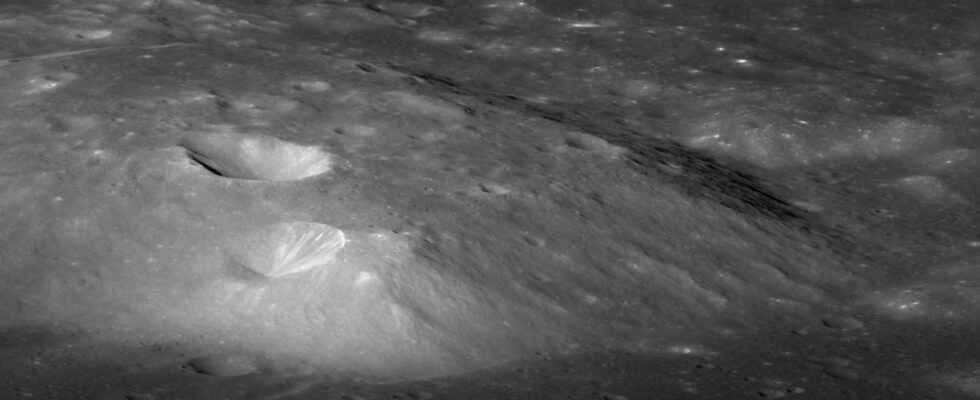The exploration and colonization of Mars is a dream, but the Moon is more within reach. Our natural satellite still contains many secrets and the announced return of both rovers andHomo sapiens, on the surface of the Moon during the 2020 decade should provide us with spectacular images, especially if we take into account the fact that they may be in relief in the metaverse.
Among the enigmas waiting to be solved with the Moon, we can cite that of the nature of the mascons, although we already have very plausible ideas about themand also the nature of volcanic domes of Gruithuisen, named in honor of Franz von Gruithuisen (1774-1852), a naturalist and astronomer Bavarian.
To understand why the Gruithuisen domes are a lunar geological mystery, we must already know that two main types of rock dominate the surface of the Moon, the basalt of the lunar seas and theanorthosite from the highlands. They are easily spotted by color from Earth – basalts are indicated by dark areas and anorthosites by brighter regions.
However, mineralogical and morphological studies of the Moon’s surface carried out using orbiting satellites capable of remote sensing and high-resolution imagery resolutionsuch as the Lunar Reconnaissance Orbiter (LRO) from NASA or Kaguya of the Jaxa, revealed some anomalies. They are usually a few scattered and relatively small volcanic centers composed of rocks rich in silicasuch as the rhyolite or dacite, i.e. extrusive volcanic versions of granite or granodiorite. This is the case of the Gruithuisen domes, whose chemical composition deduced from measurements made with the instrument Divining by LRO really suggests that it is a volcanic edifice similar to some of those known on Earth which are formed of rocks much richer in silica than the basalts of the ocean floor.
Volcanoes produced by plate tectonics on Earth but on the Moon
Now, here is the problem, on Earth these volcanic buildings are formed in regions of subduction oceanic plates with sediment waterlogged under a continental plate. This is the case of volcanoes of the Andes, or for example the famous Mount St. Helenswhose rocks come from the cooling of magma and lava formed by complex processes that involve the remelting of rocks and sediments in subduction zones.
But, we know well that there is no tectonic plates on the Moon and even fewer oceans at the bottom of which would settle sediments. How, then, to explain the existence of the Gruithuisen domes?
Selenologists, with their knowledge of the geophysics and geochemistry of magmatic processes on Earth, have some hypotheses and models on this subject. But, as always, data is needed to confirm them… or refute them! To really do comparative planetology and volcanology, you have to go on site with instruments.
That’s good, that’s precisely what NASA wants to do, confirming with a recent announcement its interest in sending a lander in a few years time that will carry a rover with it to the top of one of the Gruithuisen domes.
Lunar-VISE will explore the mysterious Gruithuisen Domes—domes on the Moon that are suspected to be formed by sticky magma! With Lunar-VISE, we will begin to answer questions about the history of lunar volcanic activity. Congrats to Dr. Kerri Donaldson Hanna & the @UCF team! pic.twitter.com/GG7G8AIZFH
— Thomas Zurbuchen (@Dr_ThomasZ) June 2, 2022
NASA has therefore just awarded 35 million dollars to two planetary scientists, Kerri Donaldson Hanna and Adrienne Dovewho will lead this mission in the name of Lunar Vulkan Imaging and Spectroscopy Exploreri.e. Lunar VISE.
Kerri Donaldson Hanna explains about this: “ We will use a suite of instruments on a lander and a rover to study the composition of the domes, including the composition and properties of regolith and boulders and how lunar dust reacts to the lander and rover when it explore the volcanic dome. There is potentially a treasure trove of knowledge waiting to be discovered, which will not only help us develop future exploration robotics and human of the Moon, but can also help us to better understand the history of our own Planet as well as other planets of the Solar system. »
Special offer: for Father’s Day, offer the best of Science!
Your father is a great science enthusiast and unusual discoveries? And if you offer him a superb scientific exploration in paper format? Benefit from -20% on the Mag Futura (special offer: €15 instead of 19 €): 220 pages to explore 4 scientific issues that will shape our future!
Mag Futura is:
- 4 major scientific questions for 2022, from the Earth to the Moon
- 220 pages, 60 experts: no fake news, just science
- Home delivery with electronic gift card
- An independent scientific media
Interested in what you just read?
